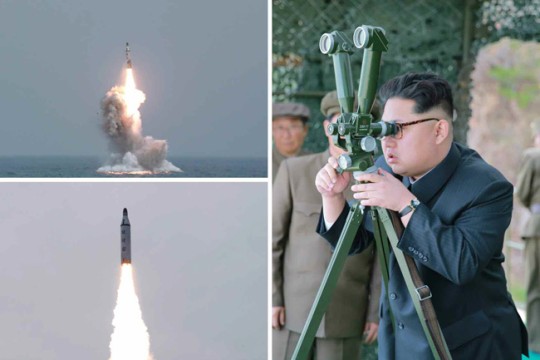|

North Korean leader Kim Jong-un watches the test-firing of a submarine-launched ballistic missile (SLBM) in this image released by Rodong Sinmun, the officialnewspaper of the North's Workers' Party, Sunday. / Yonhap
By Jun Ji-hye
North Korea is believed to have made progress in acquiring some technologies necessary for the development of a submarine-launched ballistic missile (SLBM), South Korea’s Ministry of National Defense and military experts said Sunday, following the North’s latest test-fire one day earlier.
The ministry said that the North would be able to operationally deploy the SLBMs in three or four years, adding that should the Kim Jong-un regime make a concentrated effort on the development, the new weapon may enter service earlier than estimated.
According to the Joint Chiefs of Staff (JCS), the North launched what appeared to be a ballistic missile from a 2,000-ton Sinpo-class submarine in the East Sea at 6:30 p.m. Saturday.
The JCS downplayed the test, saying the missile flew only about 30 kilometers, well short of the minimum SLBM range of 300 kilometers.
However, on Sunday, the North said it successfully launched an SLBM, claiming that the missile was launched from its maximum underwater depth, and that its “cold launch” ejection mechanism and high-performance engine using solid fuel worked without a hitch, along with its flight controls and warhead release systems, according to the state-run Korean Central News Agency (KCNA).
A cold launch is a complicated technology involving hurtling a missile out of the water to put it on trajectory for a designated target, necessary for SLBM development.
The ruling Workers’ Party’s official newspaper, the Rodong Sinmun, also released a number of photos, including one showing the missile bursting out of the water.
The ministry said, after its analysis of photos released by the North, that the North is believed to have made progress in acquiring technologies necessary to launch the missile from underwater, but still failed to prove that the projectile’s ballistic trajectory can follow a parabolic path.
“The North’s SLBM test-fire was a clear provocative action that violated U.N. resolutions. We strongly condemn the action,” ministry spokesman Moon Sang-gyun said.
Foreign ministry spokesman Cho June-hyuck also criticized the North in a rare statement, saying that the repressive state will face harsher sanctions if it continues to take provocative actions.
It was the first time that the foreign ministry spokesman issued a statement regarding the North’s SLBM test, apparently indicating that the government is taking the progress of Pyongyang’s SLBM technology seriously.
Experts also say the latest test-fire should not be characterized as a failure simply because its range fell short.
Kim Dong-yup, professor at the Institute for Far Eastern Studies (IFES), a research arm of Kyungnam University, said the North test-fired the SLBM in an area adjacent to land, which apparently means the purpose of the test was not to prove its range.
“In my opinion, letting the SLBM fly about 30 kilometers could have been enough to see its engine working well, the missile fixing its angle and flying, and after some period of time, the warhead detaching from the rocket,” Kim said. “If the North’s claims were all true, the latest test carries great significance.”
Jung Young-tae, a professor at Dongyang University and a military commentator, called the test a “half success,” saying that the North appeared to succeed in two stages _ launching a “capsule” containing the missile underwater, and then having the capsule open in the air so that the missile can be launched.
“To call the test a complete success, the range needs to be about 300 kilometers,” he told reporters.
Other experts also paid attention to photos released by the North showing that the missile soared almost vertically toward the sky this time, while one test-fired in May last year was tilted at about a 74 degree angle to the surface of the sea when it was launched.
They say this showed that there has been improvement in the North’s capability of launching the missile from underwater.
The KCNA said North Korean leader Kim Jong-un was present for the SLBM launch and stressed that Pyongyang now has the capability to strike its opponents in South Korea and the United States, with the least warning and at anytime it pleases.
Kim also said that with the SLBM launch, the North now possesses a powerful nuclear arsenal and a credible delivery system, the news agency said.
“He noted with great satisfaction that Juche Korea had access to one more means for a powerful nuclear attack as required by the strategic intention of the Party Central Committee,” the KCNA report said.
It added that the leader praised the officials, scientists and technicians in the fields of national defense science and munitions factories for having successfully developed the technology for the underwater missile launch from a submarine.
|

